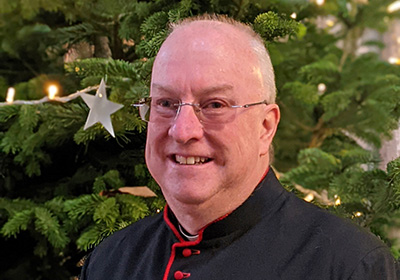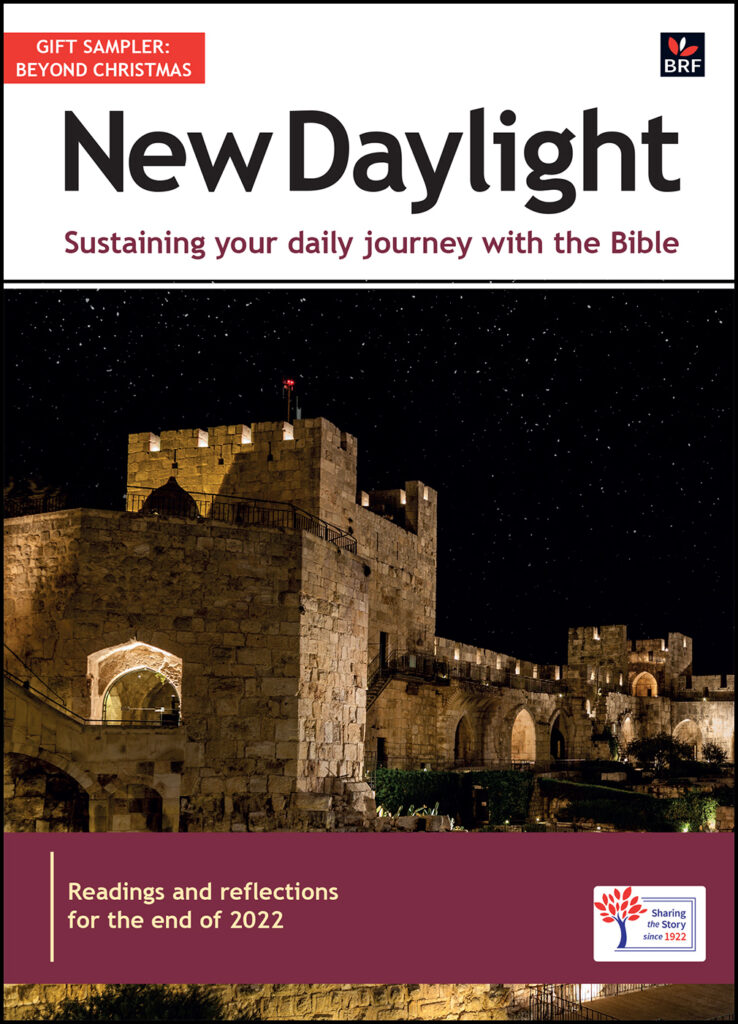Gordon Giles, canon chancellor of Rochester Cathedral, much-loved BRF author and editor of New Daylight Bible reading notes, reflects on Christmas and the days that follow.
25 December 2022
Away in a manger, no crib for a bed,
Anonymous
The little Lord Jesus laid down his sweet head;
The stars in the bright sky looked down where he lay,
The little Lord Jesus asleep on the hay.
The cattle are lowing, the baby awakes,
But little Lord Jesus no crying he makes.
I love thee, Lord Jesus! Look down from the sky,
And stay by my side until morning is nigh.
Be near me, Lord Jesus; I ask thee to stay
Close by me for ever, and love me, I pray.
Bless all the dear children in thy tender care,
And fit us for heaven, to live with thee there.
Happy Christmas!
I send greetings from everyone at BRF and wish you Christmas joy and peace wherever you are and whatever challenges, whatever blessings, you are experiencing this Christmas.
Realistically, you may not get to read this article until ‘Beyond Christmas’: that is the title of a series of reflections I have written for New Daylight, beginning on Boxing Day, which you can download as a free sampler.
By now we have been listening to – or hearing – Christmas carols for at least a month. In the coming days, as the left-over turkey and brussels sprouts are repurposed or thrown away, so too are the carols put back in their box, to be silenced for another eleven months. Strictly speaking we should not sing Christmas carols before Christmas Eve, the period preceding being Advent, when we prepare for Christmas. As with festive food, though, we anticipate the feast day by eating the food and singing the songs before as well as on the day.
God hears our cries
The meaning of the name Jesus, Yeshua (or Joshua), is not universally agreed upon, but it refers to salvation, of crying for help and of having one’s cries for help heard by almighty God. That Jesus’ very name relates to the people crying out for salvation connects us with that much-loved (and sometimes maligned) Christmas cradle song ‘Away in a Manger’.
At carol and Christingle services nationwide all ages have sung it, with lights dimmed, candles lit and many a dewy eye. Above all others it is the carol that oils the eyeballs and dampens the crustiest of cheeks. It is the carol that brings to the fore long-buried memories of Christmases past, and for some it is the very sound of Christmas. Charles Dickens, who published A Christmas Carol in December 1843, thereby ‘inventing’ Christmas as Victorian culture came to know it, did not and could not have sung it, but its widespread use and popularity has added an extra layer to the festive season presented in Christmas adverts and school nativities.
That Jesus’ very name relates to the people crying out for salvation connects us with that much-loved (and sometimes maligned) Christmas cradle song ‘Away in a Manger’.
‘Away in a Manger’ – a complicated history
The first two verses of ‘Away in a Manger’ originally appeared in 1885 in Little Children’s Book: For schools and families, by the Evangelical Lutheran Church in North America, where it was published as a nursery hymn.
James R. Murray later printed the text with his own tune, ‘Mueller’, in Dainty Songs for Little Lads and Lasses (1887), and called it ‘Luther’s Cradle Hymn’ (composed by Martin Luther and still sung by German mothers to their little ones).
The hymn, however, is not by Luther. The hymn he wrote for his five-year-old son Hans is called ‘Vom himmel hoch’ (‘From heaven I come to you’), and the two have subsequently become confused. Nor was Murray’s tune the one we use on this side of the Atlantic; ours is ‘Cradle Song’ by William Kirkpatrick (although the two tunes can be sung simultaneously with an interesting effect).
Kirkpatrick was a keen musician and composer from Pennsylvania, who wrote many hymn tunes and led worship from the violin or ‘cello, and his ‘Cradle Song’ was first heard in the musical Around the World with Christmas in 1895. There are, incidentally, 39 other tunes one might use, including a lovely tune from Normandy.
There is some debate about who wrote the words, and the three verses were not written by the same person. Exactly half way through the carol, we turn from singing about Jesus to singing to him. This is the key to the spiritual power of the song: as parents sing their babies to sleep, we sing to the Christ-child in the cradle. It helps us love him, embrace him, own him as ours. We are his and he is ours.
This is the key to the spiritual power of the song: as parents sing their babies to sleep, we sing to the Christ-child in the cradle. It helps us love him, embrace him, own him as ours.
Misinformation and mystery
When small children sing it by heart, perhaps we remember our own childhoods and picture an angelic scene with baritone cattle, starlight and the baby who is to become the bread of life, asleep in a feeding trough in the town that means ‘House of Bread’.
There is so much misinformation and mystery surrounding this simple carol which is actually all about the mysterious blend of divinity and humanity embodied in the babe of Bethlehem, who, we are told, does not cry. Yet it is we who cry, not he: for salvation, for release, for heavenly grace and for the peace of the world. And we cry out to the one whose very name is built on the cry for salvation from God’s people and the one who comes to bring that very salvation.
‘No crying he makes’ can remind us that this is not so much true of a baby who does not cry (of course every baby cries!) but of the one who in himself is the one who hears our cries.
Hope, warmth and light
These are dark days, we know, with a war in Ukraine, and crises and anxieties of our own. Even as the threats of Covid hopefully recede, we are all looking for hope and warmth and light. Warmth and light have gone up in price, and hope seems a bit thin on the ground.
Yet it is on the ground – on holy ground – where we find it: the same hope of 2,000 years ago; the same faint, fragile hope that came to a dark world back then and, in spite of everything, glimmers still amid the gas bills, newsreels, train strikes and tax returns of today.
Hope seems a bit thin on the ground. Yet it is on the ground – on holy ground – where we find it.
Mary and Joseph went to Bethlehem to be registered and taxed. No trains for them either, but Bethlehem was the tax office for the David family. Without broadband internet, the penny post or even carrier pigeons, they had no choice but to turn up. Migrants to Bethlehem, they soon became refugees in Egypt when Herod found out that their newborn baby was a special kind of threat and initiated a bloodbath the like of which we have seen too often since. Anyone who says that the world of first-century Palestine is a million miles and a thousand ages away from our time and place is not paying attention.
Nothing changes much, and yet, in that crib in which the Lord Jesus laid down his sweet head, shone the everlasting light that illuminates our souls with the perennial hopes and fears of that holy night and every night and day since.
There have been tears for sure, at every level; there are empty seats at the Christmas table as there always have been and will be, as time rolls onwards as an everlasting stream. Meanwhile the first King’s Speech for 70 years on Christmas Day refocuses remembrance of her late Majesty the Queen. Yet there have been smiles too as families and friends have been able reunite in person at Christmas, perhaps for the first time in a few years. And it is in person – in the person of Jesus Christ – the babe of Bethlehem and King of Kings who stays by us, who brings us faith, hope and love, and everlasting light.

Gordon Giles is canon chancellor of Rochester Cathedral, author of several BRF books and the editor of New Daylight.

Beyond Christmas sampler
In this set of six daily reflections for 26–31 December, Gordon Giles digs deeper into of some of our carols to see the scripture on which they stand, the ever-relevant message of peace, goodwill and joy which they bring, and the Emmanuel – God with us – whom they herald. Every Christmas carol has its own story, and often a salvation story to tell too.
Entitled ‘Beyond Christmas’, the set of reflections is taken from New Daylight September–December 2022 – one of our series of Bible reading notes available on subscription or as individual editions.
Please do share this link with anyone who might find it helpful.
Pray with us…
A new prayer for Christmas and beyond by Martyn Payne:
God who will always be beside us,
help us to remember
that it is not just for one day
that we celebrate each year,
but that your Christmas presence
is with us
for the rest of our lives to come,
whatever may happen,
and wherever we may go.
For you came not just at the right time
but for all time.
Through Christ our Lord. Amen
